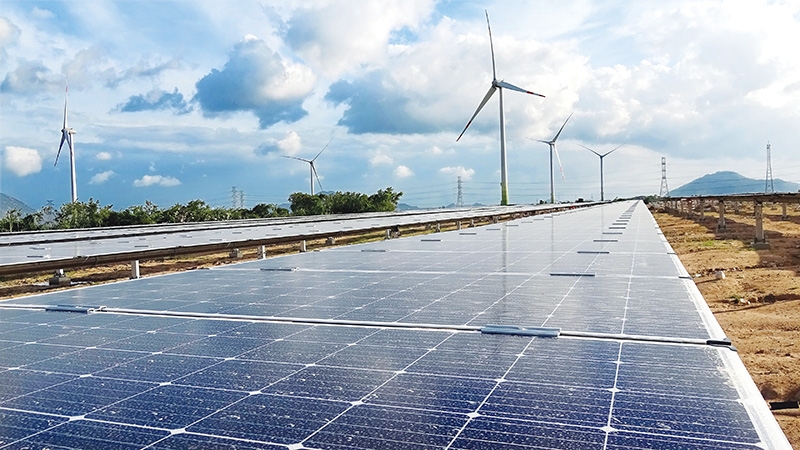Wind developers ask for transitional policy
July 28, 2021 | 14:51
 |
| Wind developers ask for transitional policy |
Having cold feet amid this year’s problems and the delay of a wind power project to reap incentives before the November feed-in tariff (FiT) deadline hits, Bui Van Thinh, chair of Binh Thuan Wind Association and CEO of Thuan Binh Wind Power JSC last week sent a petition to the prime minister. “Although wind project investors are making great efforts to get their projects online in time, due to the complicated developments of COVID-19, there are projects that will seriously struggle to reach completion before October 31, 2021,” the petition noted.
Under Decision No.39/2018/QD-TTg from 2018 adjusting support mechanisms for the development of wind power projects in Vietnam, the rate for onshore wind power is set at 8.5 US cents per kWh, and offshore wind power at 9.8 cents per kWh. These rates are applicable to projects that reach commercial operation date (COD) before October 31.
Thinh called for the government to consider extending the FiT price terms of wind power for another 3-6 months to avoid bankruptcy of a series of wind power initiatives. In turn, related investors pledge to accompany the government and localities in the pandemic battle.
This is not the first time an association and investors have called for extension of FiT incentives. Previously, the Global Wind Energy Council (GWEC) believed a strong political commitment such as FiT extension would be necessary to ensure the steady growth of wind energy in Vietnam’s power system, and to offer the prospect of a more competitive, cleaner, and secure energy pathway.
GWEC’s new report, released last week in conjunction with the Renewables Consulting Group, noted that the first large-scale offshore wind projects in the country are not likely to be connected to the grid until 2026 or later.
For these initial projects, policy clarity and transparency on procurement mechanisms are urgently needed, especially in light of the current FiT mechanism for offshore wind being due to expire in November. According to the latest report from state-run Electricity of Vietnam (EVN) on the progress of construction investment and commercial operation of wind power plant projects up to July 22, it has signed a power purchase agreement with 144 wind power projects with a total capacity of more than 8,144MW. Among that, there are 13 wind power plants with a total capacity of 611.33MW already in commercial operation.
There are 106 wind power plants with a total capacity of 5621MW which are expected to be put into commercial operation before October 31. However, as of July 22, only 61 wind power plants with a total capacity of 3,487MW sent an official letter to register for the programme of energising and connecting to the grid and testing in accordance with regulations 90 days in advance.
Currently, there are 25 wind power plants with a total capacity of 1,912MW that cannot be operated commercially by November.
Liming Qiao, Asia director of GWEC, told VIR that investors are slowing down or halting the issuance of unused monetary closure decisions and this is affecting the industry. “The impact will last for some time and we are going see a plunge in improvement by 2022-2023,” Qiao said. “This will be dodged if policymakers are mindful of the industry’s characteristics and hence can guarantee a more conducive environment for the division within the nation to develop.”
She added a new FiT for offshore wind should be applied from now to support the initial stage of 4-5GW of true offshore wind projects connecting to the grid, prior to an auction mechanism being implemented.
Mai Duy Thien, chairman of the Vietnam Clean Energy Association, explained that the pandemic is disrupting the supply of equipment, transportation, labour, and acceptance of commercial operations.
Therefore, Thien noted, the number of schemes that will not be able to operate commercially before the end of the FiT change will likely be more than forecast.
One wind developer in a southern province told VIR said that each wind power project sees an investment of trillions of VND. “If you borrow up to 80 per cent of the capital, the borrowing costs alone will cost billions,” he said.
Addressing investors’ concerns, a representative of the Ministry of Industry and Trade said, “If there is no official pricing mechanism, EVN will not sign power purchase and sale contracts. However, the ministry will coordinate with relevant agencies and units to assess the impact on each object participating in the development of renewable energy sources to have a suitable treatment mechanism.”
Vietnam’s draft Power Development Plan 8 (PDP8) contains true offshore wind targets of 2GW by 2030. However, GWEC explained in its report that high industry and investor interest indicates that Vietnam could raise its ambition to 10GW by 2030 to meet the rapidly growing power demand and increasing energy security.
“GWEC is calling on the Vietnamese government to urgently adopt a transition stage for offshore wind, and incorporate a systematic and open consultation process on future procurement and auction design,” said Qiao. “With less than 10 years to meet the PDP8 ambitions for 2030, the time is now to begin wider consultation and consider raising ambitions to 10GW by 2030.”
“The policy solution for Vietnam to accelerate offshore wind growth will require more than auctions on their own, but they could be a piece of the puzzle,” explained Michael Stephenson, associate director at the Renewables Consulting Group. “Overall, a more coordinated approach is critical, considering the interaction of auction policy with other factors such as investor confidence and supply chain maturity.”
Related Contents
Latest News
More News
- Experts highlight unpaid care work as key barrier to gender equality (December 03, 2025 | 15:15)
- Vietnam sets pace for dual transition in industry and trade (December 03, 2025 | 14:12)
- Harnessing technology for a sustainable future in Vietnam (December 03, 2025 | 12:17)
- Sustainability efforts on right track through policy and tech (December 03, 2025 | 12:05)
- Hanoi symposium highlights gender equality research and policy (December 03, 2025 | 12:00)
- The march to productivity and environmental sustainability (December 03, 2025 | 09:17)
- National cooling plan to support Vietnam’s net-zero goals (December 02, 2025 | 17:17)
- Vietnam advances ESG in finance while critical data gaps remain (December 02, 2025 | 17:10)
- Vietnam undergoes IAEA nuclear infrastructure assessment (December 02, 2025 | 16:49)
- Roadmap unveiled to tighten vehicle emission standards (November 29, 2025 | 09:00)
















What the stars mean:
★ Poor
★ ★ Promising
★★★ Good
★★★★ Very good
★★★★★ Exceptional